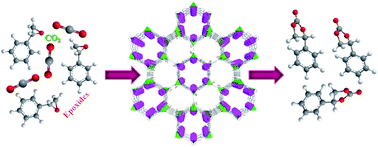Nanochannel-based heterometallic {ZnIIHoIII}–organic framework with high catalytic activity for the chemical fixation of CO2†
Abstract
The exquisite combination of ZnII and HoIII generated the highly robust [ZnHo(CO2)6(OH2)]-based heterometallic framework of {[ZnHo(TDP)(H2O)]·5H2O·3DMF}n (NUC-30, H6TDP = 2,4,6-tri(2′,4′-dicarboxyphenyl)pyridine), which featured outstanding physicochemical properties, including honeycomb nanochannels, high porosity, large specific surface area, the coexistence of highly open Lewis acid–base sites, good thermal and chemical stability, and resistance to most organic solvents. Due to its extremely unsaturated metal tetra-coordinated Zn(II) ions, hepta-coordinated Ho(III) and high faveolate void volume (61.3%), the conversion rate of styrene oxide and CO2 into cyclic carbonates in the presence of 2 mol% activated NUC-30 and 5 mol% n-Bu4NBr reached 99% under the mild conditions of 1.0 MPa and 60 °C. Furthermore, the luminescence sensing experiments proved that NUC-30 could be used as a fast, sensitive and highly efficiency sensor for the detection of Fe3+ in aqueous solution. Therefore, these results prove that nanoporous MOFs assembled from pyridine-containing polycarboxylate ligands have wide applications, such as catalysis and as luminescent materials.



 Please wait while we load your content...
Please wait while we load your content...